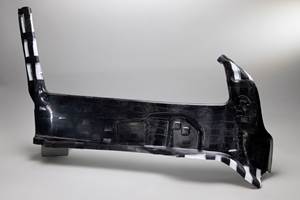Portfolio expansion adds to rCF accessibility, applications
CAMX 2025: Tennessee-based Carbon Fiber Recycling LLC grows its patented rCF offerings, extracting from post-industrial and EOL dry fiber, prepreg and cured composites.
Share
Source | Carbon Fiber Recycling LLC
(CFR, Tazewell, Tenn., U.S.) is highlighting a major expansion of its recycled carbon fiber (rCF) product portfolio and manufacturing capabilities. This strategic move enhances the accessibility and application of rCF, produced through advanced pyrolysis, to meet growing demand for sustainable, high-performance alternatives to virgin carbon fiber in industries such as aerospace, defense, automotive, infrastructure and consumer products.
CFR’s expanded offerings provide innovative solutions for post-industrial carbon fiber waste and end-of-life products, including dry fiber, prepreg and cured composites. By scaling its proprietary pyrolysis technologies, CFR delivers versatile rCF products tailored to diverse applications. The new portfolio includes:
6-mm rCF. Available in low- and high-density variants, optimized for applications requiring specific fiber length distributions, such as composites and coatings.
18-mm rCF. Ideal for processes where longer fibers enhance performance, including concrete, mortar, asphalt and nonwoven fabrics.
Milled rCF. Offered in various sizes, this product supports high-volume applications like specialized coatings, compounding and 3D printing, with improved flowability and shipping efficiency.
Pelletized rCF. A high-density option, designed for carbon fiber-reinforced plastics (CFRP), compatible with various polymers for enhanced workability, while maintaining optimal interfacial adhesion properties using select sizings. CFR’s pellets also afford an increase in shipping efficiency, eliminate bridging in feed equipment and minimize entrained dust in processing.
Nonwoven rCF. Lightweight, high-performance layups that deliver sustainability by repurposing carbon fiber otherwise destined for landfills. Nonwoven rCF is well suited for fiber-reinforced components and electromagnetic shielding/consumer electronic applications.
“Since 2018, CFR has pioneered environmentally friendly, patented technologies to extract carbon fiber from cured composites and prepregs,” says Doug Griffin, founder and CEO of CFR. “This expansion responds to customer demand for convenient, high-quality rCF products that integrate seamlessly into existing manufacturing processes, while addressing the composite industry’s sustainability needs.”
CFR says its advancements reinforce its commitment to sustainability, innovation and customer satisfaction.
Related Content
-
Highly tunable, woven lattice reinforcements target automotive structures
CAMX 2023: Startup Weav3D will be demonstrating its two collaborative automotive demonstrator parts and present two conference papers.
-
CAMX 2024 Show Daily: Wednesday, Sept. 11
The second day of CAMX 2024 has all sorts of things in store for attendees, from Tuesday’s keynote centered around the world of AI, to award and poster session winners and what to look forward to at Good Day, CAMX on Thursday.
-
"Good Day, CAMX" to discuss current challenges and future opportunities
On Nov. 1, CAMX 2023 presents an engaging and interactive discussion between Composites One’s Marcy Offner and CW’s brand VP Jeff Sloan concerning the current composites industry landscape.
Related Content
Highly tunable, woven lattice reinforcements target automotive structures
CAMX 2023: Startup Weav3D will be demonstrating its two collaborative automotive demonstrator parts and present two conference papers.
Read MoreCAMX 2024 Show Daily: Wednesday, Sept. 11
The second day of CAMX 2024 has all sorts of things in store for attendees, from Tuesday’s keynote centered around the world of AI, to award and poster session winners and what to look forward to at Good Day, CAMX on Thursday.
Read More"Good Day, CAMX" to discuss current challenges and future opportunities
On Nov. 1, CAMX 2023 presents an engaging and interactive discussion between Composites One’s Marcy Offner and CW’s brand VP Jeff Sloan concerning the current composites industry landscape.
Read MoreVIDEO: High-rate composites production for aerospace
Westlake Epoxy’s process on display at CAMX 2024 reduces cycle time from hours to just 15 minutes.
Read MoreRead Next
Scaling up, optimizing the flax fiber composite camper
Greenlander’s Sherpa RV cab, which is largely constructed from flax fiber/bio-epoxy sandwich panels, nears commercial production readiness and next-generation scale-up.
Read MoreCeramic matrix composites: Faster, cheaper, higher temperature
New players proliferate, increasing CMC materials and manufacturing capacity, novel processes and automation to meet demand for higher part volumes and performance.
Read MoreCutting 100 pounds, certification time for the X-59 nose cone
Swift Engineering used HyperX software to remove 100 pounds from 38-foot graphite/epoxy cored nose cone for X-59 supersonic aircraft.
Read More








